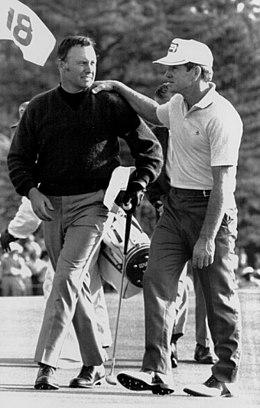Jack Nicklaus, a legendary figure in the world of golf, is renowned for his extraordinary accomplishments and lasting impact on the sport. With an extraordinary record of 18 major championships, Nicklaus epitomizes excellence in golf. His legacy extends beyond mere victories; it encompasses the principles of swing mechanics, strategic course management, and mental resilience that he has meticulously developed throughout his career. By grasping and implementing these foundational techniques, golfers of all skill levels can significantly improve their performance.
This analysis of Jack Nicklaus’ enduring golf techniques will explore the essential elements that contribute to effective play. From the significance of a deliberate, one-piece takeaway to the subtleties of maintaining proper alignment and focus, each aspect reflects Nicklaus’ thorough approach to the game. Additionally, his methods for navigating the course and fostering mental toughness provide invaluable insights for achieving sustained success. Ultimately, this examination serves as both a tribute to Nicklaus’ remarkable journey and a practical guide for golfers seeking to enhance their performance on the course.
Understanding the Fundamentals of Jack Nicklaus’ Swing Mechanics
At the core of Jack Nicklaus’ legendary success is a framework of swing mechanics that has shaped generations of golfers. His technique is characterized by a seamless blend of strength, adaptability, and precision. Key features of his mechanics include:
- Wide Backswing Arc: This allows for greater energy accumulation, crucial for maximizing distance.
- Neutral Grip Position: A balanced grip enhances consistency in shot direction and control, helping to minimize errors.
- Stable Lower Body: A solid foundation through the legs is vital, ensuring effective upper body rotation without unnecessary movements.
One of the most vital aspects of Nicklaus’ swing is his address position, which emphasizes spine angle and alignment. Proper alignment ensures that the golfer is accurately aimed at their target while maintaining a cozy posture. This results in:
- Consistent Ball Striking: Correct posture leads to improved contact with the ball.
- Enhanced Power Transfer: A stable address position allows for a smooth transition throughout the swing.
- Reduced Body Tension: A relaxed stance encourages fluidity in the swing.
Further analysis of Nicklaus’ swing mechanics highlights the significance of the follow-through. A well-executed follow-through not only completes the swing but also indicates how effectively energy has been transferred to the ball. Key aspects to consider include:
- Balanced Finish: A controlled follow-through reflects a complete and efficient swing motion.
- Head Position: Keeping the head steady helps maintain focus on the target.
- Follow-through Direction: The path the club takes after impact can indicate swing effectiveness.
Strategic Course Management: Lessons from Jack Nicklaus
Jack Nicklaus is frequently enough regarded as one of the greatest course managers in golf history, emphasizing the importance of a strategic approach to each hole. By carefully analyzing the course layout and understanding personal limitations, golfers can make informed decisions that enhance their chances of success. Key considerations for effective course management include:
- Assessing Hazard Placement: Identify obstacles such as bunkers, water hazards, and trees that could impede your shot.
- Understanding the Green: Pay attention to slopes and contours, which can influence the speed and direction of putts.
- Choosing the Right Club: Select clubs based not only on distance but also on the type of shot required for the situation.
A strategic mindset allows for adaptive play, essential for responding to changing conditions on the course. Nicklaus advocates for a holistic understanding of oneself as a player, fostering confidence when making critical decisions during play. Additionally, analyzing past rounds can reveal patterns that inform strategies for future challenges. Effective tactics include:
- Creating a Game Plan: Develop a strategy for each hole before stepping onto the tee, considering weather and ground conditions.
- Staying Composed: Focus on executing each shot as planned, regardless of previous holes’ outcomes, to maintain a consistent mental state.
- Adapting to Opponents: Be aware of competitors’ strategies and adjust your approach accordingly, especially in match play situations.
Incorporating these insights into a golfer’s routine can lead to critically important performance enhancements. Nicklaus’s advice to visualize shots before executing them fosters clarity and purpose in each movement. This approach not only improves shot accuracy but also strengthens the connection between mental and physical aspects of the game. A practical way to implement these strategies is through a simple table for planning each hole:
| Hole | Key Hazards | Club Choice | Strategy |
|---|---|---|---|
| 1 | Bunker on left | Driver | Aim right side of fairway |
| 2 | Water on approach | 7-iron | Play short of the green |
| 3 | Two trees on right | 3-wood | Use fade to navigate |
The Mental Game: Developing Resilience in Golf
Resilience is a crucial trait that sets elite golfers apart from their peers. The ability to withstand psychological pressure and recover from setbacks is essential for maintaining consistent performance. Elite players like Jack Nicklaus exemplify this quality through their mental strength. By cultivating resilience, golfers can approach challenges with a growth mindset, viewing setbacks as opportunities for advancement. Key techniques to build this resilience include:
- Positive Self-Talk: Developing an inner dialog that emphasizes strength and potential can empower golfers, especially in high-pressure situations.
- Visualization Techniques: Imagining triumphant outcomes and the steps needed to achieve them helps athletes mentally prepare for each shot’s demands.
- Mindfulness practices: Engaging in mindfulness can ground players in the present moment, reducing anxiety and enhancing focus on the task at hand.
Nicklaus’s career illustrates that resilience is not just about bouncing back from mistakes but also about maintaining a steadfast focus on one’s goals. A significant aspect of this focus involves embracing realistic expectations while remaining committed to excellence. During tournaments, golfers benefit from a structured routine that minimizes anxiety and reinforces concentration. Implementing a personal pre-shot routine serves to align the body and mentally prepare for upcoming challenges. Consider the following essential components when developing a consistent routine:
| Routine Component | Description |
|---|---|
| Preparation Phase | Analyze the shot, assess wind conditions, and visualize the desired outcome. |
| Breathing Exercises | Inhale deeply to relax the body and ensure optimal focus. |
| Final Check | Reaffirm commitment to the shot before initiating the swing. |
Ultimately, the journey toward resilience involves continuous learning and adaptation. By incorporating mental techniques that promote resilience, golfers can enhance their ability to perform under pressure. This approach not only fosters a strong mental game but also aligns players with the timeless principles that Jack Nicklaus embodies—persistence, focus, and an unwavering commitment to improvement. Embracing these strategies can lead to significant enhancements in overall performance and enjoyment of the game.
Practice Regimens: Implementing Nicklaus’ Techniques for Consistent Improvement
To develop a consistent and effective practice regimen, integrating Jack Nicklaus’ iconic techniques is essential for any aspiring golfer. His focus on detailed analysis and methodical repetition serves as a foundation for skill development. A well-structured practice plan should include:
- Evaluation of Key Fundamentals: Concentrate on grip, stance, and alignment.
- Targeted Drills: Use specific drills to enhance swing mechanics and putting accuracy.
- Performance Review: Regularly assess progress through video analysis or peer feedback.
Nicklaus’ practice strategies emphasize the importance of consistency over volume. He advocates for quality practice sessions that incorporate a mix of gameplay simulation, skill drills, and mental training. For example, a practice session might consist of:
| Session Component | Duration |
|---|---|
| Short Game Drills | 30 minutes |
| Long Game Practice | 45 minutes |
| Course Simulation | 30 minutes |
| Mental Visualization Techniques | 15 minutes |
Nicklaus highlights the significance of mental resilience during practice. Incorporating techniques such as visualization and breathing exercises can greatly enhance focus and overall performance. Engaging in these practices will help players manage pressure situations throughout their rounds. To solidify these concepts, it is crucial to adopt a proactive approach in maintaining a growth mindset:
- Set Clear Goals: Establish both short-term and long-term objectives.
- Adapt and Learn: Be open to adjusting techniques based on performance feedback.
- Stay Committed: Consistency is vital for achieving lasting improvement.
Adapting Timeless Principles for Today’s Golf Environment
In the contemporary golfing landscape, adapting Jack Nicklaus’ basic principles is essential for remaining competitive. His approach emphasizes a solid foundation of swing mechanics, which can be tailored to fit advancements in technology and training methodologies prevalent today. For instance, the six keys to his swing—address, takeaway, top, downswing, impact, and release—can be enhanced using data from launch monitors and video analysis. This combination allows golfers to refine their mechanics while retaining the timeless techniques that have proven successful over decades.
Moreover, the course management strategies employed by Nicklaus can seamlessly integrate with today’s statistical analysis tools. By applying analytical insights on course layouts and player tendencies, golfers can make informed decisions that reflect Nicklaus’ strategic thinking. Players are encouraged to focus on their strengths and adapt to the course’s demands, guiding their shot selections with a blend of instinct and statistical backing. Such an approach fosters a greater understanding of risk versus reward, ultimately leading to improved decision-making on the course.
Lastly, mental resilience, a cornerstone of Nicklaus’ philosophy, remains crucial in today’s high-pressure environments. Modern players can benefit from mental conditioning techniques, such as visualization and routine-building that align with Nicklaus’ focus on mental fortitude. Incorporating mindfulness practices helps golfers enhance their concentration during critical moments and fosters a calm demeanor in high-stakes situations. As competition intensifies, the ability to maintain composure and a strong mental game is as important as technical skills, ensuring a holistic approach to performance improvement.
Conclusion
The lasting legacy of Jack Nicklaus extends far beyond the trophies and accolades he earned throughout his illustrious career. His timeless techniques, characterized by a harmonious blend of rhythm, precision, and mental fortitude, serve as a guiding light for golfers at all levels seeking to elevate their performance. By embracing the principles outlined in this analysis—his meticulous approach to swing mechanics, strategic course management, and unwavering psychological resilience—players can cultivate a deeper understanding of the game. As we continue to explore and appreciate the nuances of Nicklaus’ methods, we not only honor his contributions to golf but also equip ourselves with the tools necessary for personal improvement and competitive success. Let us strive to embody the spirit of the Golden Bear in our own endeavors on the course, celebrating the artistry and intellect that define the game of golf.





